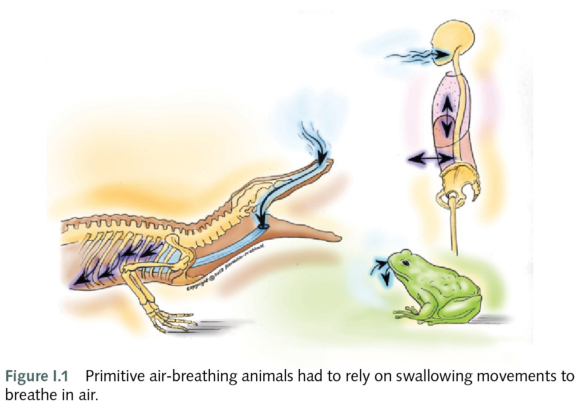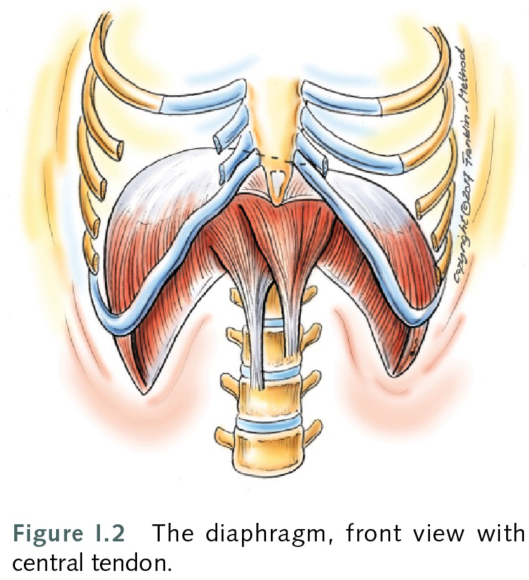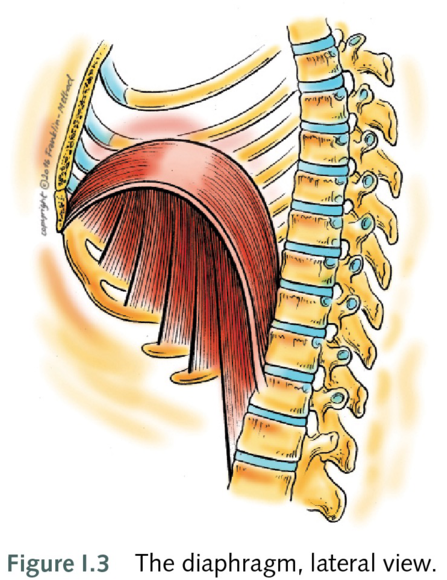How your upper body is designed for breathing
This is an excerpt from Breathing for Peak Performance by Eric Franklin.
The Evolution of Breathing
The first water-living animals breathed through their skin. This method worked fine if they were small enough and plenty of flowing water was available. Some early animals that lived in fresh water started to move around a lot, so breathing through the skin was not sufficient. Multiple folded flaps (gills) developed to increase the surface area for absorption of oxygen. These gills were enhanced by primitive expansions of the pharynx (the part of the throat behind the nose and mouth) into early lungs. However, gills are not suited for breathing in air, and primitive air-breathing animals such as frogs had to rely on swallowing movements to gulp in air (figure I.1).

The breakthrough came with the advent of negative-pressure breathing, called thoracic breathing. The ribs attached themselves to the sternum in front, creating an expandable rib cage. This adaptation allowed the ribs to rotate and swivel toward the head for inhalation and reverse this action for exhalation. This movement, which is like lifting a bucket handle, increased the side-to-side diameter of the rib cage, creating a vacuum in the lungs and causing the air to rush in.
This evolution was a great improvement over gulping air, but it came at a price. The negative pressure in the thorax not only appeared to suck in air, it also pulled the belly organs upward, and much of the space that could have been used for breathing was occupied. Primitive reptiles solved the problem by stretching a sheet of connective tissue across the bottom of the rib cage, preventing the organs from moving upward. This sheet still exists as the modern central tendon of the diaphragm (figure I.2).

Mammals, who were warm blooded, needed a higher oxygen intake. Their breathing had to become more effective at drawing oxygen into the lungs with the purpose of increasing their metabolism. Having warm blood was an advantage. They did not need to live in a warm climate for the sun to heat the body until the muscles could start functioning; the body could warm itself even in a cold environment.
Muscles were attached to the rim of the central tendon and stretched down to the lower edge of the thorax, creating a muscular dome with a tendinous roof. This diaphragm could now move downward and flatten out, allowing for a large downward expansion in the lungs and greatly increasing the capacity to absorb oxygen. In fact, resting mammals can breathe with minimal movement of the ribs. As you are reading this book—unless you are running on a treadmill—you will probably not notice much movement of the rib cage. This kind of breathing, called abdominal breathing, probably explains why mammals lack ribs below the 12th thoracic vertebra. As you inhale, the organs below the diaphragm are pushed downward by the descending diaphragm. The abdominal wall moves outward to accommodate their movement, something that would not be possible with a bony wall of ribs (see figure I.3).

SHOP

Get the latest insights with regular newsletters, plus periodic product information and special insider offers.
JOIN NOW
Latest Posts
- Authenticity was key to McKinney’s NIL success
- AI—A new tool for sport PR pros
- Essential skills for sport PR practitioners
- Employ these tactics when pitching a story to the media
- How does ergonomic analysis and intervention enhance safety and reduce injury risk?
- Common movement patterns in competitive cycling


